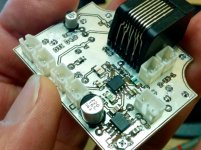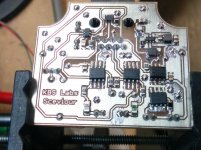Greetings.
First of all i would like to apologise for my english if it is bad, i assure you it is not out of dissrespect for the language, and also apologise if the subject has been already discussed, the search on the forum did not gave me the answers i needed.
Now let's get to bussines. I have searched for info on my dillema but came up short, maybe it's my lack of chemistry skills ( i wasn't exactly a model student at chemistry class ), i am etching my own boards whenever i need them using the photo method, i use NaOH ( Sodium hydroxide ) as a developer, about 2 spoons of the flaky stuff for 2,5 litres of water, and FeCl3 ( Ferric chloride ) for etching, the diluted stuff ( as it seams it's offly diluted at the store that i am buying it from ). I have managed to get the methode working verry well, every single board comes out just fine, but even though i do not possess good chemistry skills still i know i am working with potential toxic chemical stuff, so i would verry much like to know just how toxic are they?
In the summer or whenever the weather permit's it, i am working outside so ventilation is not a problem, but now that the cold season has begun to make it's self noticed i am forced to work indoors, for the developing stage i still go outside, but the etching is done in the workshop, i keep the windows wide opened, i use rubber gloves and sometimes a simple mask, basically a piece of sterile cloth with elastic strings ( u know the stuff i'm sure ). I use a plastic box with a lid on it ( the ones with the lid designed for them ) but it is not air tight so the smelly stuff still makes it's self noticed ( although much less than without the lid ).
Ok now u know just about everything there is to know about what i am doing, so again please let me know how dangerous are they? I am talking mainly about the potential toxic vapors that can be inhalled. I need them boards, so i need to keep using them, but i also do not need some form of cancer or other tipe of poisoning, so i need to know if what i am doing it's wrong from the safety point of view and if something more can be done to make it safer.
Thanks for reading my topic, and for any response u feel u can post here.
Respectfully, Marian.
First of all i would like to apologise for my english if it is bad, i assure you it is not out of dissrespect for the language, and also apologise if the subject has been already discussed, the search on the forum did not gave me the answers i needed.
Now let's get to bussines. I have searched for info on my dillema but came up short, maybe it's my lack of chemistry skills ( i wasn't exactly a model student at chemistry class ), i am etching my own boards whenever i need them using the photo method, i use NaOH ( Sodium hydroxide ) as a developer, about 2 spoons of the flaky stuff for 2,5 litres of water, and FeCl3 ( Ferric chloride ) for etching, the diluted stuff ( as it seams it's offly diluted at the store that i am buying it from ). I have managed to get the methode working verry well, every single board comes out just fine, but even though i do not possess good chemistry skills still i know i am working with potential toxic chemical stuff, so i would verry much like to know just how toxic are they?
In the summer or whenever the weather permit's it, i am working outside so ventilation is not a problem, but now that the cold season has begun to make it's self noticed i am forced to work indoors, for the developing stage i still go outside, but the etching is done in the workshop, i keep the windows wide opened, i use rubber gloves and sometimes a simple mask, basically a piece of sterile cloth with elastic strings ( u know the stuff i'm sure ). I use a plastic box with a lid on it ( the ones with the lid designed for them ) but it is not air tight so the smelly stuff still makes it's self noticed ( although much less than without the lid ).
Ok now u know just about everything there is to know about what i am doing, so again please let me know how dangerous are they? I am talking mainly about the potential toxic vapors that can be inhalled. I need them boards, so i need to keep using them, but i also do not need some form of cancer or other tipe of poisoning, so i need to know if what i am doing it's wrong from the safety point of view and if something more can be done to make it safer.
Thanks for reading my topic, and for any response u feel u can post here.
Respectfully, Marian.
Last edited:
Ferric Chloride is corosive, Ultra Violet light will give headaches and as long as you take care not to spill anything, all is quite straight forward. The only hazard being the mess.
If strong, chloride vapors will irritate your lungs, but windows open + lid on tank is enough to make it manageable.
I do the same, I have an electrically heated 30Kg perchloride tank and have no problems.
It always has the cover on, and water condenses on the lid.
But everything iron or brass around it rusts or turns green 🙁
I do the same, I have an electrically heated 30Kg perchloride tank and have no problems.
It always has the cover on, and water condenses on the lid.
But everything iron or brass around it rusts or turns green 🙁
I don't think the vapors are anything to worry about. FeCl3 seems to etch stainless steel, and will stain other things, so the main issue for me is avoiding splashes.
Coating boards is smelly; my roommates objected when I used the kitchen oven to dry the boards, for some reason.
Coating boards is smelly; my roommates objected when I used the kitchen oven to dry the boards, for some reason.
Vapors are clorhidric acid !!!!!I don't think the vapors are anything to worry about.
Perchoride by itself is a solid but when in solution in water it partly decomposes and one sub-product is clorhidric acid , which can and does evaporate.
By the way, that's what attacks metals all around.
I use a heated ferric chloride etching tank. Whenever I'm done with it I cover the top with saran wrap and put the lid back on. This works great to keep all the vapours contained in the tank and if you push the wrap in a bit before replacing the lid it will create a low point for condensation to drip back into the tank. I have no issues at all with odours or unwanted etching of metal hanging around the tank.
Any attempts I have made at my own pcb's were a disaster.
Over etching and under etching in different amounts on the same pcb !
I just design my own pcb and get them made in China.
I get a good price and good quality in 2 weeks turnaround time.
Over etching and under etching in different amounts on the same pcb !
I just design my own pcb and get them made in China.
I get a good price and good quality in 2 weeks turnaround time.
If you are doing single sided boards float the board copper side down and cut your etching and chemical exposure time in less than half! Copper is heavy and as it is dissolved away it falls to the bottom of the container and fresh etching solution is always in contact with the copper. It goes really fast so rinse and check so you don't over etch. I have never over etched but I see others in this thread have had that problem.
I suppose you can do double sided by etching one side at a time. I never had a G-4 board that would not float.
Mark
I suppose you can do double sided by etching one side at a time. I never had a G-4 board that would not float.
Mark
Etching systems are fairly cheap https://www.circuitspecialists.com/416-e.html
or you can build your own. Undercutting and loss of detail occurs in cold etching because of the time it takes. Large areas of copper take so much time that the really fine stuff gets compromised. Ferrric chloride works best at 50C and it etches fast with no undercutting. A typical board takes just a few minutes. This is a double sided board that etched in under 4 minutes. I often etch test point numbers and other important details right into the board.
or you can build your own. Undercutting and loss of detail occurs in cold etching because of the time it takes. Large areas of copper take so much time that the really fine stuff gets compromised. Ferrric chloride works best at 50C and it etches fast with no undercutting. A typical board takes just a few minutes. This is a double sided board that etched in under 4 minutes. I often etch test point numbers and other important details right into the board.
Attachments
I use Liquid Tin from MG Chemicals. Just place the board in pure solution for a few minutes. Never a problem with oxidation and the board stays bright and clean.
Liquid Tin | MG Chemicals
Liquid Tin | MG Chemicals
- Status
- Not open for further replies.
- Home
- Design & Build
- Construction Tips
- PCB etching -> The foto method -> Riscs involved

